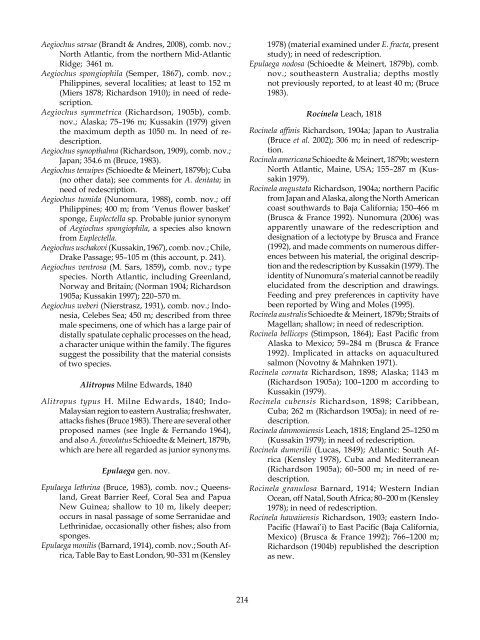The Marine Fauna of New Zealand: Isopoda, Aegidae (Crustacea)
The Marine Fauna of New Zealand: Isopoda, Aegidae (Crustacea)
The Marine Fauna of New Zealand: Isopoda, Aegidae (Crustacea)
Create successful ePaper yourself
Turn your PDF publications into a flip-book with our unique Google optimized e-Paper software.
Aegiochus sarsae (Brandt & Andres, 2008), comb. nov.;<br />
North Atlantic, from the northern Mid-Atlantic<br />
Ridge; 346 m.<br />
Aegiochus spongiophila (Semper, 867), comb. nov.;<br />
Philippines, several localities; at least to 52 m<br />
(Miers 878; Richardson 9 0); in need <strong>of</strong> redescription.<br />
Aegiochus symmetrica (Richardson, 905b), comb.<br />
nov.; Alaska; 75– 96 m; Kussakin ( 979) given<br />
the maximum depth as 050 m. In need <strong>of</strong> redescription.<br />
Aegiochus synopthalma (Richardson, 909), comb. nov.;<br />
Japan; 354.6 m (Bruce, 983).<br />
Aegiochus tenuipes (Schioedte & Meinert, 879b); Cuba<br />
(no other data); see comments for A. dentata; in<br />
need <strong>of</strong> redescription.<br />
Aegiochus tumida (Nunomura, 988), comb. nov.; <strong>of</strong>f<br />
Philippines; 400 m; from ‘Venus flower basket’<br />
sponge, Euplectella sp. Probable junior synonym<br />
<strong>of</strong> Aegiochus spongiophila, a species also known<br />
from Euplectella.<br />
Aegiochus uschakovi (Kussakin, 967), comb. nov.; Chile,<br />
Drake Passage; 95– 05 m (this account, p. 24 ).<br />
Aegiochus ventrosa (M. Sars, 859), comb. nov.; type<br />
species. North Atlantic, including Greenland,<br />
Norway and Britain; (Norman 904; Richardson<br />
905a; Kussakin 997); 220–570 m.<br />
Aegiochus weberi (Nierstrasz, 93 ), comb. nov.; Indonesia,<br />
Celebes Sea; 450 m; described from three<br />
male specimens, one <strong>of</strong> which has a large pair <strong>of</strong><br />
distally spatulate cephalic processes on the head,<br />
a character unique within the family. <strong>The</strong> figures<br />
suggest the possibility that the material consists<br />
<strong>of</strong> two species.<br />
Alitropus Milne Edwards, 840<br />
Alitropus typus H. Milne Edwards, 840; Indo-<br />
Malaysian region to eastern Australia; freshwater,<br />
attacks fishes (Bruce 1983). <strong>The</strong>re are several other<br />
proposed names (see Ingle & Fernando 964),<br />
and also A. foveolatus Schioedte & Meinert, 879b,<br />
which are here all regarded as junior synonyms.<br />
Epulaega gen. nov.<br />
Epulaega lethrina (Bruce, 983), comb. nov.; Queensland,<br />
Great Barrier Reef, Coral Sea and Papua<br />
<strong>New</strong> Guinea; shallow to 0 m, likely deeper;<br />
occurs in nasal passage <strong>of</strong> some Serranidae and<br />
Lethrinidae, occasionally other fishes; also from<br />
sponges.<br />
Epulaega monilis (Barnard, 9 4), comb. nov.; South Africa,<br />
Table Bay to East London, 90–33 m (Kensley<br />
2 4<br />
978) (material examined under E. fracta, present<br />
study); in need <strong>of</strong> redescription.<br />
Epulaega nodosa (Schioedte & Meinert, 879b), comb.<br />
nov.; southeastern Australia; depths mostly<br />
not previously reported, to at least 40 m; (Bruce<br />
983).<br />
Rocinela Leach, 8 8<br />
Rocinela affinis Richardson, 904a; Japan to Australia<br />
(Bruce et al. 2002); 306 m; in need <strong>of</strong> redescription.<br />
Rocinela americana Schioedte & Meinert, 879b; western<br />
North Atlantic, Maine, USA; 55–287 m (Kussakin<br />
979).<br />
Rocinela angustata Richardson, 1904a; northern Pacific<br />
from Japan and Alaska, along the North American<br />
coast southwards to Baja California; 50–466 m<br />
(Brusca & France 992). Nunomura (2006) was<br />
apparently unaware <strong>of</strong> the redescription and<br />
designation <strong>of</strong> a lectotype by Brusca and France<br />
( 992), and made comments on numerous differences<br />
between his material, the original description<br />
and the redescription by Kussakin ( 979). <strong>The</strong><br />
identity <strong>of</strong> Nunomura’s material cannot be readily<br />
elucidated from the description and drawings.<br />
Feeding and prey preferences in captivity have<br />
been reported by Wing and Moles ( 995).<br />
Rocinela australis Schioedte & Meinert, 879b; Straits <strong>of</strong><br />
Magellan; shallow; in need <strong>of</strong> redescription.<br />
Rocinela belliceps (Stimpson, 1864); East Pacific from<br />
Alaska to Mexico; 59–284 m (Brusca & France<br />
992). Implicated in attacks on aquacultured<br />
salmon (Novotny & Mahnken 97 ).<br />
Rocinela cornuta Richardson, 898; Alaska; 43 m<br />
(Richardson 905a); 00– 200 m according to<br />
Kussakin ( 979).<br />
Rocinela cubensis Richardson, 898; Caribbean,<br />
Cuba; 262 m (Richardson 905a); in need <strong>of</strong> re-<br />
description.<br />
Rocinela danmoniensis Leach, 8 8; England 25– 250 m<br />
(Kussakin 979); in need <strong>of</strong> redescription.<br />
Rocinela dumerilii (Lucas, 849); Atlantic: South Africa<br />
(Kensley 978), Cuba and Mediterranean<br />
(Richardson 905a); 60–500 m; in need <strong>of</strong> re-<br />
description.<br />
Rocinela granulosa Barnard, 9 4; Western Indian<br />
Ocean, <strong>of</strong>f Natal, South Africa; 80–200 m (Kensley<br />
978); in need <strong>of</strong> redescription.<br />
Rocinela hawaiiensis Richardson, 903; eastern Indo-<br />
Pacific (Hawai’i) to East Pacific (Baja California,<br />
Mexico) (Brusca & France 992); 766– 200 m;<br />
Richardson ( 904b) republished the description<br />
as new.

















